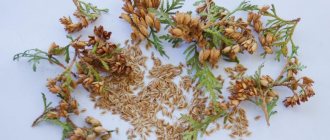Review author: Terrari School of Design
We can safely say that Phlox remains a favorite in the country landscape. And all because the perennial is distinguished by its variety of colors, aroma and ability to decorate any flower beds.
70 species of phlox are now known. But only half of them are used. The most famous, of course, is Phlox paniculata, its varieties and hybrids have long gone ahead of their ancestors in terms of the wide variety of flower colors. Many of today's hybrids have been bred to be resistant to powdery mildew.
More than 1000 new flowers were developed in our country alone. The uncultivated form, in its natural habitat, grows everywhere.
Medium sized plants will look great alone or in a group
The height of a bush is its species: there are very small ones below 35 cm, and there are very tall varieties, above 160 cm. Which allows you to divide phloxes into groups, according to this criterion:
- tall (up to 180 cm), flowering - summer and early autumn: Phlox paniculata;
- bush, height up to 70 cm, beginning of flowering - from the end of April: thick-leaved phlox, f. hairy, etc.;
- a transitional species, there are bush varieties and there are creeping varieties (up to 35 cm), flowering begins from April to July. Phlox spread apart (spread out) and phlox stoloniferous;
- creeping plants, up to 15 cm in height, bloom from spring to mid-summer. F. awl-shaped, f. Douglas, etc.;
- Drummond phlox, one of the favorite garden annuals, should be placed in a separate group. The height does not exceed 30 cm. The flower is painted in all sorts of colors and shades: from white to purple. Flowering is friendly and long. Propagates well by self-sowing.
Phlox awl-shaped is a perennial, no more than 17 cm in height. Flowering is early, late May. Forms a continuous carpet. The flowers are small, of different colors - from white to blue.
The plant looks very decorative due to its evergreen elongated leaves. Great for alpine slides. Popular varieties f. awl-shaped: Maishnee, Appel Blossum, Thumbelina, Candy stripes.
The individuality of each variety is also evident in the inflorescence. Plants differ in the shape and size of the inflorescence, as well as in the color of the flower. Breeders in many countries continue to work on flower color all the time. The color of various hybrids is impressive: white, coral, pink, red, crimson, purple, violet, lilac. There are Dutch hybrids that change color depending on the time of day.
Description of the flower
Phlox flowers are annual and perennial ornamental herbaceous plants of the Cynuaceae family. They come from North America - it is believed that due to this they are highly resistant to disease and cold. There are as many as 70 species in the genus, of which only 20 are subject to cultivation and selection.
From Greek “phlox” is translated as “flame”. This name was given to the plant by Karl Lineus himself, presumably because of the bright inflorescences.
The appearance of plants varies greatly from species to species. Among them there are both subshrubs and upright bushes. Some species bloom in spring, others in summer and even autumn. Some species look more like moss than flowers. Among the entire family you can find very small ones about 20 cm in height and mighty giants up to two meters in height. The shape of the leaves also varies greatly, and the flowers during the flowering period vary from two to four centimeters in diameter.
Care
Spring
- Perennial plantings of phlox require care. The old bush is divided and cuttings can begin. It's time to tie up tall varieties.
- Spring is the time when you need to apply a complex fertilizer with a predominance of nitrogen. In the absence of rain, watering is required.
Summer
- If phloxes are planted on poor soils, then feed them with nitrogen again in June.
- In July, water with an infusion of wood ash; after the phloxes have flowered, apply phosphorus-based fertilizer.
- In summer, control over self-seeding is important. In order not to lose the characteristics of the variety, and to prolong flowering, you need to remove faded inflorescences. And don't forget to water.
- Landscape design: giant varietal plants can fit perfectly into the background of a flower bed.
Autumn
- In September it is time to divide the bush. Phloxes are cut to the ground.
- For the winter, the bush is mulched and, if necessary, covered with additional material.
Advice. In order for the flowerbed to be decorative and blooming all season long, you should plant together: Phloxes, daylilies and peonies.
Cereals, monardas, and saplings are perfect for phloxes in pink, lilac, and purple tones.
Conditions for growing phlox flowers in open ground: planting and care (with video)
Special conditions for growing phlox are needed; in particular, they should not be planted near trees and shrubs with a shallow root system: for example, near spruce, birch, apple trees, and chokeberries, since they actively absorb moisture from the soil. It is recommended to avoid placing phlox flowers for growing next to barberry and pine. These crops are intermediate hosts of the rust fungus, which attacks many plants, including, although rarely, phlox.
For growing phlox in open ground, low places flooded by melt water and heavy rains are not allowed. Good predecessors for phlox are irises, marigolds, calendula, nasturtium, and eschscholzia.
Phlox love loose, fertile, well-saturated soil that is not clogged with weeds. They grow well on neutral, slightly alkaline and slightly acidic soils (pH 6.0 - 7.5).
The absorption of mineral substances from the soil by plants is associated with the respiration of roots, which results in the generation of energy necessary for the nutrition process. But if the soil is very dense or excessively wet, the roots constantly lack oxygen and cannot fully absorb nutrients, even when there are enough. Planting phlox in open ground and subsequent care of the crop requires regular application of mineral and organic fertilizers.
Air permeability of the soil is achieved by adding slightly decomposed peat, finely chopped moss, half-rotted leaf soil and other raising agents.
An increase in soil moisture capacity is achieved by adding organic components: peat, humus, leaf soil, compost. These materials, with the exception of high-moor peat, contain humic substances that allow them to retain water well. Raised, slightly decomposed peat, as well as sphagnum moss, do not contain humus substances, but retain water well due to the special cellular structure of peat-forming plants.
Watch the video of growing phlox, which shows all the main agrotechnical aspects of care:
Location and lighting
The plant can grow both in the sun and in the shade, but in the sun the phlox flowers will be better and the inflorescence itself will be more magnificent, while in the shade the flower will be duller and the inflorescences will be loose. But the shade will allow the phlox to bloom longer. In southern regions, shading is required.
Advice. In order for the plants to bloom for a long time, you should plant them in the “Sherbet Cocktail” or “Sherbet Blend” area - these varieties bloom for the longest time.
Getting ready for winter
In the southern regions there is no need to cover plants. But already from the middle zone for the winter they need to be “bundled” from the cold. Before this, they are cut off at the root.
We recommend reading:
- Flowers in August: photos and description
- Garden flowers that bloom in July: photos and names
- Lilac - varieties, types, selection rules, planting nuances, cultivation secrets and care (105 photos and videos)
The root part is mulched with straw and other organic matter. Burlap and agrofibre cope well with the task. In the northern regions, roots are dug up and stored in basements or boxes.
Temperature
In winter, down to -15°C (without snow cover), 2 weeks are enough for the growth buds to freeze out, and at -20...-25°C the rhizome will die irrevocably. To prevent this from happening, you should cover the wintering plant with bast leaves, not with woven material.
If there is up to half a meter of snow, the plant, without harming itself, can overwinter without additional shelter even at -35°C.
Growing from seeds
The collected seeds can be planted before winter as late as possible. Even if snow has fallen, we simply shovel it to the side and scatter the seeds over the surface. Then we sprinkle a 1.5-centimeter layer of pre-prepared loose soil and return the snow to its place. This method does not guarantee 100% germination. For example, I hatched at most 70%.
In the spring, when the sprouts have already produced 4-5 leaves, we pick the seedlings.
In the same way, we plant seeds on the surface in the spring, leaving a distance of 3-4 cm between them. We moisten them well with a spray bottle and cover them with film. We ventilate and remove condensation every day. We remove the covering when shoots appear.
All the secrets of caring for beautiful flowers in this video:
Humidity
Phlox love moisture, but cannot tolerate standing water at their roots. Lowlands, where water collects and stands for a long time, and where ice forms in cold weather, are not the place for them.
Advice. To avoid rotting of phlox roots when groundwater is shallow, it is necessary to plant the plant on a raised bed (up to 15 cm).
Transfer
Basically, only perennial species are replanted and only after 4-5 years of growing in one place. In this case, replanting will rejuvenate the plants.
Bushes are replanted in several cases:
- if after rapid growth you need to thin out the flower bed,
- if the transplant is due to design ideas,
- if the perennial has been growing in the same place for about 3-5 years.
In other cases, it is recommended to avoid transplantation - phloxes tolerate it quite painfully.
Transplantation in case of illness
If the phloxes are sick, replanting may be necessary to improve the health of the bushes.
Transplantation is carried out in the fall, after flowering.
- The stems are carefully dug out along with a lump of earth on the roots and transferred to a new place.
- It is best to cover the transplanted bushes with something - for some time after transplantation the plants get sick, they have reduced immunity and resistance to cold.
Otherwise, transplantation is easy, and death is usually not observed.
Reproduction
Phlox reproduce in all sorts of ways.
Seeds
The flower produces good germination from self-sowing. But varietal affiliation disappears. This method is good for annual phlox drummondi.
Stem cuttings
The method is simple for beginner phlox lovers. A strong shoot is suitable for cuttings. Divide into cuttings with two nodes. The cuttings are planted in the ground. Water frequently - up to 3 times a day. After rooting, young shoots will emerge from the leaf axils.
Root cuttings
This method is best used in the spring. After digging up the flower, select a high-quality root and cut it into pieces. Place in a container with soil and cover from light. Keep at 15°C for 14 days. Then raise the temperature to 25°C and plant in the soil when sprouts appear.
Axillary buds
Along with a small piece of the stem, a leaf with a bud is cut off. This cutting is planted in the ground and covered with glass, the temperature is no more than 20°C. The substrate is wet. Rooting will occur in approximately 30 days if watering standards are observed.
Dividing the bush
The procedure is carried out in spring and autumn. The division of the bush begins at 6 years of age. The bush is dug up and taken apart. Planting is done immediately, watering is required. Phlox varieties are preserved in this way.
Popular varieties
All phloxes are a unique culture, with their own characteristics and character. But, as always happens, some species are more loved by gardeners than others. For example: red wings, petticoats, blue dreams and albatrosses.
Red Wings
Want a large flower bed filled with bright pink flowers? Red wings are perfect for this! Not whimsical and not requiring special care, bushes no more than 20 cm high not only easily tolerate heat and cold snaps, but also bloom twice a season: at the beginning of summer and at the beginning of autumn.
Petticoat
Five Y-shaped white petals form the flowers of this interesting variety. Petticoats easily survive cold snaps and grow in soil consisting mainly of sand and pebbles. This feature can help out the gardener when there are no other options for planting something in such infertile soil.
Blue dreams
Small, neat and very frequent light blue flowers of this low-growing variety can cover both sunny and shaded areas of your garden like a carpet. The main flowering time is at the beginning of the season.
Albatross
Don't want to deal with diseased flowers? Although this variety does not guarantee complete freedom from such a possibility, it is much more resistant to diseases than its brothers in the family. In addition, the albatross has beautiful white, pink and bluish inflorescences with a diameter of about 4 cm. It also easily tolerates heat and cold.
Diseases
If brown, loose spots appear on the stem, this is Phoma. With this disease, the leaves curl and dry out. The use of the drugs “Hom” and “Abiga-Peak” will help. The amount of mineral fertilizers should be applied. Those plants that are not deficient in phosphorus and potassium are resistant. But with an excess of nitrogen fertilizers, the immunity of phloxes weakens.
If not properly cared for, phlox will look depressed and weak; plants suffering from lack of water will develop powdery mildew. The disease begins from the lower part of the plant with the appearance of plaque on the leaves. Then the plaque darkens, and these spots cover the entire plant. Treatment - “Skor”, “Topaz”, “Ridomil Gold”
Advice: Remove and burn a plant infected with powdery mildew. Disinfect working tools.
Wintering
Preparing for winter will not take you much time. The stems are cut so that no more than 15 cm remain. All leaves and other plant remains must be carefully collected - they can become a breeding ground for pathogenic fungi. The remaining part of the stem is wrapped in agrofibre or burlap - several small holes are made in the fabric for ventilation. The ground around the stems is covered with straw or sawdust.
Like if you liked the article and write your additions for other gardeners in the comments.
Photos of phlox
How to sow phlox seeds
We plant it straight into the garden. You can sow the achenes directly into the ground, spreading them every 5 cm in rows 1 cm deep. Having distributed the achenes among the rows, sprinkle them with soil.
We plant in seedlings. We grow planting material in a container in advance, keeping the container with the sown seeds for a couple of weeks in a cold place. We provide the seedlings with a warm place, good lighting, and timely watering. We plant the plants in the garden when 4 leaves appear.
Planting with seeds is good because the bushes become more powerful and healthy, but, unfortunately, they may lose some of the characteristics inherent in the variety.
Latest articles about gardening
How to feed carrots for a good harvest
How to feed the money tree at home?
How to feed geraniums for abundant flowering?
If you want to divide the bushes in the fall, plant the separated bushes in early September, cutting the stems by a third: rooting will happen faster and easier. For the winter, we insulate the plantings with mulch. The first shoots will appear in the spring, as soon as the snow melts.
Planting of separated bushes is carried out as follows:
We dig up the bush to be divided, remove it from the ground and cut off the stems, leaving cuttings 15 cm long.
We separate the roots using a sharp knife: each separated bush should have 2-5 buds.
We make large holes, fill them with ash (a large handful) and compost (half a bucket), and mix the additives with the soil.
Pour water into the holes, place a bush, sprinkle with soil, covering the growth points by 4-5 cm.
We tamp the soil around the bushes, add a layer of compost and tamp again.
At the end of planting, cover the soil around the plants with a ten-centimeter layer of mulch, using peat or straw.
Choosing quality soils
For phlox in a flower garden, it is necessary to provide high-quality, well-developed soil. Like all typical perennial flowerbed inhabitants, phlox develops best on sandy and loamy soils. They need nutritious, light, loose soil, at least slightly moist, but preventing waterlogging, previously improved by applying fertilizers and deep repeated digging.
For bush phlox, all types of compacted, sandy, and also excessively dry soil mixtures are absolutely not suitable, in which normal tall greenery will not form and it is impossible to achieve flowering typical for the variety.











